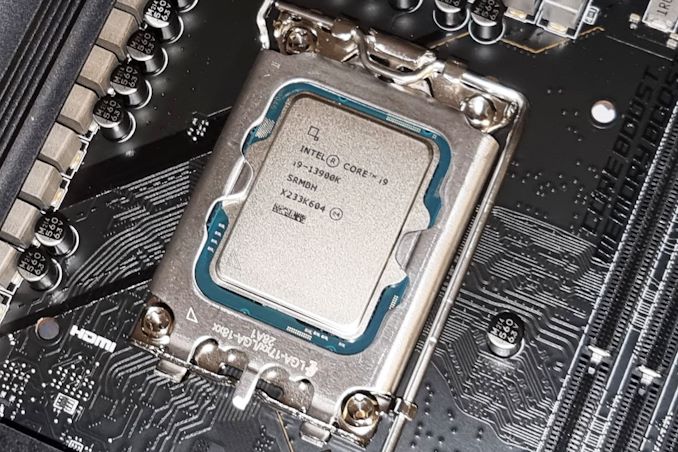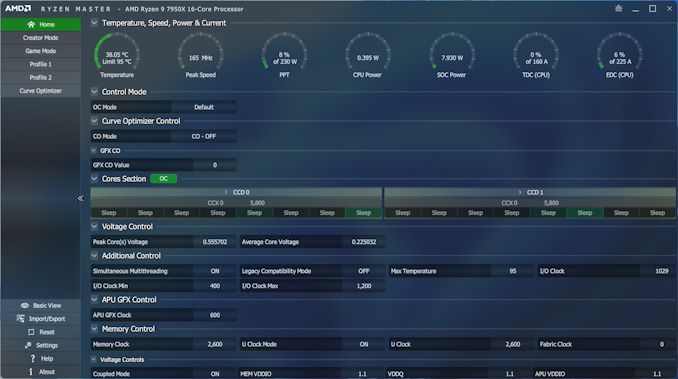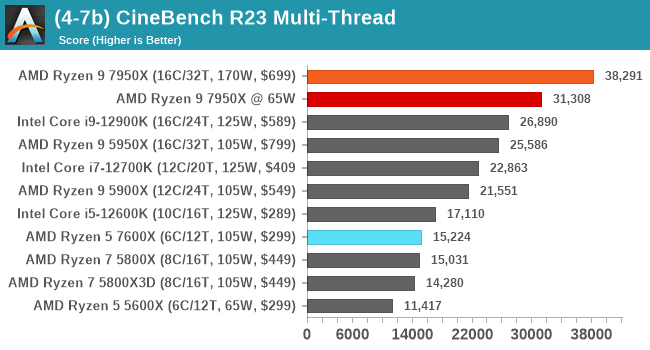A Lighter Touch: Exploring CPU Power Scaling On Core i9-13900K and Ryzen 9 7950X
by Gavin Bonshor on January 6, 2023 8:00 AM EST- Posted in
- CPUs
- AMD
- Intel
- 65W
- TDP
- Ryzen 9 7950X
- Core i9-13900K
- Power Scaling
- Efficiency
- 105W
- 125W
- 253W
- 230W
- PPT

One of the biggest running gags on social media and Reddit is how hot and power hungry CPUs have become over the years. Whereas at one time flagship x86 CPUs didn't even require a heatsink, they can now saturate whole radiators. Thankfully, it's not quite to the levels of a nuclear reactor, as the memes go – but as the kids say these days, it's also not a nothingburger. Designing for higher TDPs and greater power consumption has allowed chipmakers to keep pushing the envelope in terms of performance – something that's no easy feat in a post-Dennard world – but it's certainly created some new headaches regarding power consumption and heat in the process. Something that, for better or worse, the latest flagship chips from both AMD and Intel exemplify.
But despite these general trends, this doesn't mean that a high performance desktop CPU also needs to be a power hog. In our review of AMD's Ryzen 9 7950X, our testing showed that even capped at a these days pedestrian 65 Watts, the 7950X could deliver a significant amount of performance at less than half its normal power consumption.
If you'll pardon the pun, power efficiency has become a hot talking point these days, as enthusiasts look to save on their energy bills (especially in Europe) while still enjoying fast CPU performance, looking for other ways to take advantage of the full silicon capabilities of AMD's Raphael and Intel's Raptor Lake-S platforms besides stuffing the chips with as many joules as possible. All the while, the small form factor market remains a steadfast outpost for high efficiency chips, where cooler chips are critical for building smaller and more compact systems that can forego the need for large cooling systems.
All of this is to say that while it's great to see the envelope pushed in terms of peak performance, the typical focus on how an unlocked chip scales when overclocking (pushing CPU frequency and CPU VCore voltages) is just one way to look at overall CPU performance. So today we are going to go the other way, and to take a look at overall energy efficiency for users – to see what happens when we aim for the sweet spot on the voltage/frequency curve. To that end, today we're investigating how the Intel Core i9-13900K and AMD Ryzen 9 7950X perform at different power levels, and to see what kind of benefits power scaling can provide compared to stock settings.
The Ever Changing Definition of TDP (Thermal Design Power)
One of the most frustrating talking points surrounding processors involves TDP, or more specifically, what TDP even is. While the term has a fixed definition – Thermal Design Power – what that actually means in regards to the specifications of a product varies from one hardware maker to the next. Even Intel and AMD have slightly different definitions of TDP (despite sharing the x86 CPU market), which makes it a complicated and at-times confusing term. In short, TDP is no longer an unflinching guide to the maximum power consumption from a specific processor – or even how much heat energy can dissipate from a processor
This is is a matter we have given plenty of column inches to over the years, so below are some previous articles on the subject of power and TDP:
- Why Intel Processors Draw More Power Than Expected: TDP and Turbo Explained
- Talking TDP, Turbo, and Overclocking: An Interview with Intel Fellow Guy Therien
Starting with Intel, while the company assigns official TDP figures to its processors, the reality is that their unlocked processors are not limited to one assigned power figure. At best, Intel offers a set of TDP values based around the base frequency of their chips, while power level 1 (PL1) and power level 2 (PL2) ratings are laid on top of that to define the power parameters for those all-important (and all-advertised) turbo clock speeds.
Meanwhile, looking at how AMD defines its TDP figures has been made more difficult with the release of its Ryzen 7000 series processors and the accompanying AM5 platform. While AMD does give out default TDP figures the Ryzen 7000 series, this is no more a hard ceiling than it is with Intel; the other element is what AMD calls Package Power Tracking, or PPT for short. The defined TDP value is assigned to its processors based on default frequency levels, while PPT is defined as the limitation to what the actual socket can deliver in terms of power (and what flagship chips tuned for maximum performance will try to consume).
The long and short of matters is that, on practically any consumer-level motherboard paired with an adequate cooler, using any unlocked processor, including the two we're focusing on today, will circumvent the chip's base TDP rating in order to provide the highest turbo clock speeds possible, capped only by the temperature and electrical delivery limits. So taking the Ryzen 9 7950X as an example, although the default TDP is 170 W, the actual PPT wattage is defined as 230 W (with a sustained current of 160 A).
The good news, however, is that these power limits are easily user-adjustable on both AMD and Intel platforms. Many motherboards for both platforms offer a plethora of adjustable values to raise and lower these limits, and even within Windows there are software packages like AMD's Ryzen Master and Intel's XTU that can make the necessary changes.
Finding The Sweet Spot Balance Between Performance, Power, and Heat
For its latest series of processors, AMD is offering a new feature called ECO Mode, which reduces a 170 W TDP-rated processor to 105 W (and a 105 W TDP-rated processor down to 65 W). When we reviewed the AMD Ryzen 9 7950X processor, we found some interesting results when using it at 65 W instead of its default value of 170 W.
The most important thing we observed was that at 65 W, the Ryzen 9 7950X processor outperformed the Intel Core i9-12900K at default settings in the CineBench R23 multi-threaded test, which is nothing short of impressive. Since then, Intel released its 13th Gen Core series codenamed Raptor Lake, so the overall playing field has been leveled some. But still, it shows the potential value in dialing down the power consumption of a flagship CPU, as the 7950X was able to deliver 80% of its peak performance at under half the power consumption.
Those findings, in turn, inspired the thesis behind this doing this article: we wondered how both the Core i9-13900K and Ryzen 9 7950X performed when using it with various power restrictions applied. So for this article, we're going ahead and testing just that situation, running AMD and Intel's flagship CPUs are various power levels.
We've selected several power limits/PPTs to test, including the following:
- Intel Core i9-13900K at default settings (125 W base, 253 W turbo)
- AMD Ryzen 9 7950X at default settings (170 W base, 230 W PPT)
- Both at 125 W
- Both at 105 W
- Both at 65 W
- Both at 35 W
Throughout all of this, it's important to note that the Intel Core i9-13900K and AMD Ryzen 9 7950X have a critical distinction in terms of construction: chiplets. Whereas the Core i9-13900K is a monolithic design with cache, core, memory controller (IMC), and iGPU all being built within a single die, AMD's Ryzen 9 7950X is built upon a chiplet design. As a result, the 7950X uses three different chiplets for all of its major functions, with two eight-core core complex dies (CCD) and one IO die (IOD) containing the memory controller, PCIe, and graphics.

A screenshot from AMD's Ryzen Master Overclocking software during testing
This means that when setting a defined power limited with the Core i9-13900K, it's limiting power from all of the variables as mentioned. Whereas doing the same on the Ryzen 9 7950X wouldn't yield the quite same effect, as the IOD and CCDs operate semi-independently, albeit through AMD's Infinity Fabric interconnect. To properly limit the power on the Ryzen 9 7950X, the Package Power Tracking limit would need to be applied to constrict the power limits properly, such as setting a value of 125 W on the PPT and not just on the CPU cores.
Test Bed and Setup
Since both Intel and AMD use different platforms and sockets, we're using the MSI MPG Z790 Carbon WIFI for the Core i9-13900K and the GIGABYTE X670E Aorus Master for the Ryzen 9 7950X. To try and keep things on a level playing field, we're using an SK Hynix Platinum P41 2TB NVMe storage drive and AMD Radeon RX 6950 XT graphics card.
Normally we would rely on JEDEC memory settings defined by each platform, but in this case, we've opted to test both platforms with the same SK Hynix DDR5-5600B CL46 memory configuration. This is the memory we used for the Intel Core i9-13900K review, but it's faster than the highest official JEDEC settings supported by AMD's Ryzen 7000 series platform (DDR5-5200). Either way, we wanted to make our comparisons as apples-to-apples as possible, including holding memory at a constant performance and power level to investigate the benefits (if any) of restricting system power draw.
| Power Scaling Test Bed (DDR5) Intel & AMD |
|
| CPUs | Core i9-13900K ($589) 24 Cores, 32 Threads 125 W Base, 253 W Turbo Ryzen 9 7950X ($699) 16 Cores, 32 Threads 170 W Base, 230 W PPT |
| Motherboards | MSI MPG Z790 Carbon WIFI (13900K) GIGABYTE X670E Aorus Master (7950X) |
| Memory | SK Hynix 2x16 GB DDR5-5600B CL46 |
| Cooling | EKWB EK-AIO Elite 360 D-RGB 360mm |
| Storage | SK Hynix Platinum P41 2TB PCIe 4.0 x4 |
| Power Supply | Corsair HX1000 |
| GPUs | AMD Radeon RX 6950 XT, 31.0.12019 |
| Operating Systems | Windows 11 22H2 |
Regarding benchmarks, we've opted for a small selection of rendering and encoding tests as we believe these will highlight differences in processor performance at the different power levels. For gaming, we've opted for Total War: Warhammer 3, as this is a notoriously heavily CPU-dependent title, while Borderlands 3 is more graphically demanding. We thought it would be prudent to test one of each, although if anyone would like to request more titles from our CPU 2023 benchmarking suite, feel free, and we'll add data as we find the time to collect and collate it.











61 Comments
View All Comments
ingwe - Friday, January 6, 2023 - link
Really cool testing. If I had an 7950, I wouldn't be running it higher than 105W. Then again, I have a 5600 and I am running that at 45 W. Feels like the gains these days aren't generally worth the power (for my use cases and especially for AMD). I am surprised by how well Intel's performance scales with power. I would be curious how 12th gen looks since this isn't their first gen with high power consumption they may have done a lot better designing for power scaling.deksman2 - Friday, January 6, 2023 - link
Yeah. I think AMD's sweet spot for Zen 4 should have remained 105W like last gen.They could have introduced 170W for a bit of extra performance... but otherwise make a statement that there was too much in diminishing returns.
7900x and 7950x should probably be run at 105W by default... you get 6.4% less performance at nearly 50% lower power draw (vs 170W), and generally, lower temps.
fybyfyby - Saturday, January 7, 2023 - link
They needed 170/230 target only for compete with Intel. Otherwise it doesn't make sense. I tried all eco modes and I'm perfectly fine with 65w. 105w is identical as my former 5900x wattage - in reality it is peaked around 145w. They needed to max out stock settings, but there is no need to use that for any ordinary user.DanNeely - Monday, January 9, 2023 - link
I'm really disappointed with Intel, AMD, NVidia, and AMD (again); all their current generation products are dragging high end overclocking power levels and resultingly terrible power efficiency into stock performance packages.Hulk - Friday, January 6, 2023 - link
I think you need to include at least one power level between 125W and 230W. That's quite a spread there that has no data that might change your conclusions had you included say 170W and 200W in the data.Also outside of benchmarks many real world applications don't saturate the individual cores enough to demand a lot of power. In these cases performances is more about how high the lightly loaded cores will scale rather than power limiting performance. This is exactly what you saw with the gaming tests and is why real world workloads should have been made before making conclusions.
But then again I'm almost afraid to criticize because I appreciate any new content on Anandtech these days!
repoman27 - Friday, January 6, 2023 - link
"I appreciate any new content on Anandtech these days!"—Amen to that.While I agree that the sampling points chosen make it more difficult to visualize the curve, it clearly starts to bend significantly between 65 and 105 W and has flattened out substantially by the time you hit 125 W. So personally, I'd be much more interested in seeing performance at 80 and 95 W instead, as the best power / performance trade-off is probably somewhere around there. Which, not coincidentally, is also where desktop CPU TDPs traditionally were, before Intel ran into process issues.
@gavbon, peak power is really not relevant to either TDP or power efficiency. And given their myriad differences, comparing temperatures as reported by these two CPUs seems unlikely to yield any meaningful takeaways. I'm not sure how Andrei used to do it, but running SPEC CPU 2017 (a fixed workload) while measuring the energy usage in Joules is pretty much the holy grail as far as efficiency is concerned.
Hresna - Tuesday, January 17, 2023 - link
I agree it would be great to see the curve - I was inspired to plot it myself for 13900k.https://www.reddit.com/r/hardware/comments/10bna5r...
This is essential coverage though, great to see Anandtech adopting this. I would love to see detailed power curves become standard for desktop chips going forward. If I had a 7950x to play with, it would be amazing to have both curves not he same chart. The inflexion points in the bend are sensitive so I might need to make some inferences but could use the Anandtech data as a starting point.
edzieba - Friday, January 6, 2023 - link
It would be interesting to plot benchmark performance vs. /actual/ power consumption rather than /reported/ consumption, as the Y-cruncher results on the last page show that the Ryzen chips are significantly underreporting power consumption vs. Intel (with the 105W capped Ryzen pulling the same power as the 125W-capped Intel). A scatterplot of normalised-per-benchmark scoring vs. measured power should result in a trend per CPU illustrating power scaling behaviour for different workloads.repoman27 - Friday, January 6, 2023 - link
The yCruncher chart shows peak power, which tells us essentially nothing about power consumption. If we knew the average power and duration of the test, we could infer energy usage. Peak power only gives us the magnitude of the largest recorded current spike during the test.Gavin Bonshor - Friday, January 6, 2023 - link
You are not wrong, if I get time over the weekend, I'll add some additional graphs profiling the power usage over one or two of the runs.